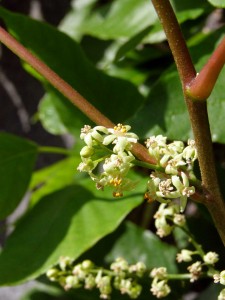Little green flowers
By Ken Moore
I’ve always been fascinated with greenish flowers and I wonder why so many of our native vines have them.
On your next outdoors excursion, keep a keen eye focused on the native greenbriers or catbriers, wild grapes and the not-so-welcome poison ivy. During this mid-spring season, you can spy clusters of greenish-yellow flowers hanging beneath the leaves of these common vines climbing trees and fences and scrambling over field edges everywhere.
My favorite is the greenbrier, Smilax rotundifolia, being the most common of several species in our region. I have allowed a volunteer smilax full reign over the trellis along my deck where I look forward to the return of little green flower clusters each spring. I also never tire of the heart-shaped leaves sprawling here and there.
If you take a closer look, you’ll find clusters of tiny green lily-like flowers hanging beneath the leaves. The smilax vine scrambling along my deck is a male, so I don’t get the clusters of black berries that birds enjoy on the female vines in the late fall. The shoots and berries of the many species of smilax are important food for a diversity of wildlife, including black bear.
Cut stems are effective in flower arrangements throughout the year. Being drought tolerant, smilax vines are attractive all during the growing season and birds take advantage of the climbing stems on my deck for cover and easy access to the bird feeder. Whenever it begins to over stretch, it is easily trimmed back. Not all greenbriers are thorny catbriers, so we need not curse them.
Native-American ethnobotany references describe countless medicinal, culinary and other uses, including grinding tubers for making bread, using stems and leaves for herbal teas and salves, use of the thorns as a type of acupuncture, tying thorny vines together for protective barriers and using vines in basket making, a rich heritage indeed.

With caution, you can get close enough to see the greenish flowers of poison ivy. Photo by Ken Moore
In addition to wild grapes, you’ll find greenish flowers on that vine-to-avoid, poison ivy, Toxicodendron radicans. Now, I don’t expect many of you even think of getting close enough to see the flowers. You have to be very careful not to touch any part of the vine as you take that closer look at the clusters of green flower buds, opening with cream-colored petals and contrasting orange stamens. Poison ivy is another valuable food plant for pollinating insects as well as birds and small mammals, and the fall color can provide spectacular red tints where the vine is climbing high in pines.
The best way to observe poison ivy flowers is with binoculars. I use binoculars for wildflower viewing all the time. You can take closer looks at flowers without leaving the trail and you certainly won’t have to walk through the poison ivy.
For the next couple of weeks, keep your eyes alert for the yellow-green flowers hidden under the leaves of these vines and perhaps you can discover an advantage for being green.



Comments are closed.